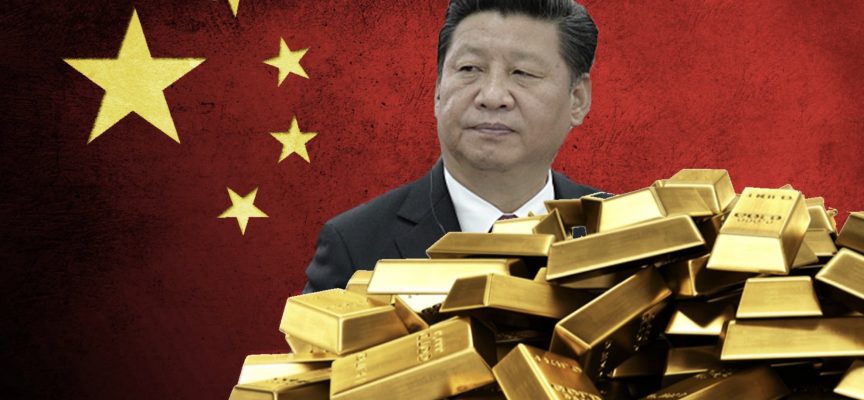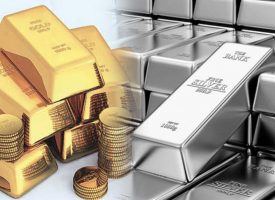On the heels of a fascinating start to 2017, one of the greats in the business, John Hathaway, says China is preparing to radically reprice gold higher as the demise of the COMEX & LBMA accelerates.
By John Hathaway, Tocqueville Gold Fund
January 13 (King World News) – Gold rose 8.5% for the year while gold-mining stocks (XAU – Philadelphia Gold and Silver Index stocks) rose 75%. On an annual basis, results were highly satisfactory. However, there was considerable drama beneath the surface that left precious metals investors in a state of anxiety by year-end. Precious metals and mining shares rose sharply through August, and then spent the rest of the year giving back much of the first-half gains. The second half downtrend accelerated into early December, following the unexpected victory by Trump and a hawkish statement after the December Federal Open Market Committee (FOMC) meeting…
IMPORTANT:
To find out which high-grade silver mining company billionaire Eric Sprott just purchased
a nearly 20% stake in and learn why he believes this is one of the most
exciting silver stories in the world – CLICK HERE OR BELOW:
The Next Big Change In The Gold Price Will Be Substantially Higher
The question of the hour is whether the 2016 gains were merely a countertrend rally following a four-and-a-half-year decline from all-time highs in 2011, or the beginning of a new leg in the secular bull market that began in 1999, during which gold rose from less than $300/oz. to $1900 in August 2011. We judge the weight of current sentiment, mainstream media opinion, and technical analysis to be extremely bearish, comparable to year-end 2015 just prior to the dramatic gains that followed. We believe that, based on prevailing negativity, the next big change in the gold price will be substantially higher. If so, the 2016 second-half correction will have established a durable higher low from the advance that began at year-end 2015, and would be the precursor to the continuation of the secular advance that began in 2000.
Fundamentals of physical supply and demand remain positive, and are reinforced by the current extended regime of precious metals prices too low to justify expanded mine supply. Global mine output has plateaued; it now seems likely to decline through 2020 and perhaps into the middle of the next decade. As shown in the chart below, discoveries of new ore bodies are at a 25-year low, while the time required to bring new ore bodies into production continues to lengthen, and now stands at nearly 20 years.

Physical demand continues to show steady secular growth, primarily in Asia. Consumption by Turkey, India, China, and Russia alone have exceeded global mine supply since 2013, which means that inventories of physical metal held in Western vaults are being depleted to meet that demand.

Two recent developments (largely ignored by mainstream media) will, in our opinion, significantly strengthen the demand for and usage of physical metal. First, a new Shariah gold standard was approved in December 2016:
The AAOIFI [Accounting and Auditing Organization for Islamic Financial Institutions], in collaboration with the World Gold Council (WGC) and Amanie Advisors, has approved what will become known as the Shariah Gold Standard. This is a set of guidelines that will expand the variety and use of gold-based products in Islamic Finance. (Jan Skoyles, Goldcore Research, 12/16)
We believe that this will lead to the creation of investment products such as gold ETFs for the Islamic world (25% of global population), a market that has not been penetrated. While estimates of the potential market size vary wildly, and this development is in its early days, it seems to us that it is a major positive for future physical gold consumption.
 China Moving To Dominate World Oil Trade In Yuan Backed By Gold
China Moving To Dominate World Oil Trade In Yuan Backed By Gold
Second is the incorporation of gold as a settlement currency to facilitate trade between oil-producing nations and the world’s largest hydrocarbon importer, China. Russia, Saudi Arabia, and Iran are settling most, if not all, of their energy sales to China in yuan convertible into physical gold via the Shanghai Gold Exchange. That flow represents a significant and growing percentage of international oil commerce, which in turn represents a dominant share of all commodities.
China Preparing To Radically Reprice Gold Higher
We believe that this development has negative implications for the petrodollar system that has underpinned the dollar’s dominance in global commerce since the 1970s. Physical settlement, as opposed to paper (cash-settled) gold contracts, ramps up the migration of physical metal to Asian owners. Gold has become a reserve asset that is preferred to US Treasuries. Comments below by Xu Luode, chairman of the Shanghai Gold Exchange, show that the Chinese have made no secret of their strategy to internationalize the renminbi through gold convertibility in order to displace the US dollar:
Foreign investors can directly use offshore yuan to trade gold on the SGE international board, which is promoting the internationalization of the renminbi…Shanghai Gold will change the current gold market “consumption in the East priced in the West” situation. When China will have a right to speak in the international gold market, pricing will get revealed… (Xu Luode, speech to LBMA, May 2014)
Demise Of The COMEX And The LBMA To Accelerate
We believe that the expansion of gold’s utility as a settlement currency will accelerate the demise of paper-centric traditional institutions such as COMEX and LBMA, and greatly diminish the influence of speculative paper flows in the process of price discovery. An excellent in-depth discussion of China’s pro-gold/anti-dollar strategy can be found in the 11/21/16 issue of Grant Williams’ “Things That Make You Go Hmmm.” In addition, according to Luke Gromen (Forest for the Trees (FFTT), 1/3/17), “China is accelerating the pace at which it moves towards being able to print CNY for oil and other critical imports, and in so doing is accelerating the pace of ‘de-dollarization’/global currency system restructuring.” A link to HSBC research provided in the same issue shows that more than 25% of China’s trade is now settled in CNY.
Despite an unequivocally bullish prognosis for higher gold prices based on physical flows, short-to-intermediate-term price changes are more heavily influenced by investment accumulation or divestment of synthetic gold positions (paper contracts) on COMEX or similar exchanges than by intermediate physical market flows. Synthetic or paper gold positions are cash-settled, and only remotely connected (if at all) to ownership of physical metal.
Synthetic trading is highly volatile. Position swings are driven mainly by highly changeable macroeconomic perceptions. Directional changes are accentuated by high-frequency traders who account for approximately two-thirds of COMEX volume. Unlike traditional CTA traders who cohabit the COMEX floor and take long or short positions based on speculative macro views, HFT traders are agnostic as to fundamentals and serve primarily as directional accelerants to existing price trends, leading to overshoots on the upside as well as the downside.
Largest Six-Month Reduction In Commercial Shorts On Record
First-half 2016 gains were inflated by speculative money flows. It appears that hot-money excesses that built up in the first half have been largely worked off based on COT (Commitment of Traders) positioning reported weekly. The COT reports show that the first-half rise was driven by net accumulation of 300,000 contracts (roughly 30 million ounces of gold) and the second half by the liquidation of 200,000 contracts. According to Meridian Macro (12/31/16 Gold & Silver Report), commercial interests that take the opposite (short) side of speculative longs reported the largest six-month reduction in contracts on record. These changes were mirrored in all gold ETFs, which saw an increase in ounces of 19.1 million through October 20 and a liquidation of 7.4 million ounces by year-end. It appears to us that the stage is set for a return of speculative interest during 2017.
Synthetic-gold trading is driven, in our opinion, by market perception of the macroeconomic outlook, with scant attention paid to gold-specific fundamentals. These highly speculative bets are subject to sudden reversal. Exhibit A would be the 180-degree shift in expectations for economic growth and interest rates following the unexpected Trump electoral victory, which was also viewed as a game-changer for gold. As observed by Eric Pomboy of Meridian Macro, in the four trading days following the election, approximately 6200 tonnes of gold (2,000,000 contracts) were transacted based on reported COMEX volume. That is equivalent to two years of global gold mining production based on World Gold Council Statistics. That hair-trigger trading reaction led to a price smash of 4.5% and turned the trading sentiment for gold from positive to negative almost overnight.
“The Selling Was Almost Entirely Synthetic”
The question is where did sellers come up with 6200 tonnes – a preposterously enormous and unprecedented quantity of gold – on a moment’s notice, in the wee hours following the surprising election outcome? The answer is that nothing close to that quantity of gold changed hands in those four days. The selling was almost entirely synthetic, as there would have been, in our opinion, no possibility that that amount of physical gold, or even 10% of that amount, could be mobilized on short notice.
The suddenly contrived post-election bearish speculation was that gold under Trump would be hurt by rising fiscal deficits and interest rates, coupled with a return to robust economic growth and, consequently, a rising stock market. We shall see. While euphoria over the prospects of a more pro-business economic policy is understandable, we believe that realities may fall short of these high expectations.
It is a little-known fact that gold has outperformed equities and bonds since 2000 (see chart below). While a change in political direction may be welcome, the history of the past 16 years suggests that that the case for gold transcends partisan politics. It remains to be seen whether the kind of real change necessary to diminish the systemic risks created by 16 years of radical monetary policy can occur without inflicting considerable damage to financial asset values.

“In our view, the systemic risks that existed prior to the presidential election have not suddenly vanished. Most important among these is a massive bond-market bubble. Close behind, equity valuations remain at historically extreme levels. (“Trump’s Victory: What Does It Mean for Gold?” Tocqueville website article, 11/16)”
Lessons From Reagan’s Landslide Victory
Lofty expectations for Trump the miracle worker are reminiscent, in our opinion, of the euphoria that followed Reagan’s landslide victory in 1980. As the following quote from August 1982 – more than two years after the Reagan victory – illustrates, those initial high expectations were not rewarded before considerable market pain:
There is certainly good reason for pessimism. The Dow Jones Industrial average, battered by the protracted recession, a deepening erosion of corporate profits, and anxieties that brokerage firms as well as banks are becoming increasingly vulnerable, slid 45 points in eight straight days…. The average is down almost 25 percent from its peak in April 1981…Even more disorienting is what investors perceive to be the disarray in economic policy and the abandonment of economic leadership in Washington: the inability of anyone to cut the Federal budget, the flight of economic advisers from the Reagan Administration, and most recently, President Reagan’s sudden repudiation of his own tax cuts in favor of a $99 billion tax increase. (“Dark Days on Wall Street,” by William Shepherd, New York Times, 8/15/82)
In other words, anything can happen. The room for disappointment is substantial, given that the optimists have overcrowded one side of the boat. The 1982 example shows that serious attempts to address past policy ills do not come without collateral pain. In our view, the amount of work to be done on the fiscal and monetary front dwarfs the task of the 1980 Reagan administration. Moreover, Reaganites had the advantage of extremely undervalued equity and bond markets, just the opposite of present-day circumstances. We therefore think the likelihood is excellent that bearish speculative sentiment with respect to gold will revert to positive in 2017.
Shortage Of Available Physical Gold Will Deepen
Summing up, there is a shortage of physical metal at current prices that promises to deepen, masked only by the supply of synthetic gold not backed by physical. Given full transparency, the shortage would argue for a much higher gold price based on price discovery unimpeded by synthetic-gold trading. The progressive hollowing out of the (mostly Western) synthetic price-setting mechanisms and institutions is not a headline-grabbing process. The only clue is the steady seepage of bullion from Western storage vaults into Asian hands, where it is welcomed at bargain prices and utilized within a far friendlier institutional and political context. Advocates of this point of view must have been cheered (as were we) by the fact that GLD, the largest gold ETF, resorted to borrowing 29 tonnes in Q1 2016 from the Bank of England to connect the inflow of money flows with the physical metal necessary to back the trust instrument (from the Q1 10Q). As Trump might tweet, “Not good!!!” With the passage of time, the disparity between real (physical) and imaginary (speculative) fundamentals continues to widen. The longer it persists, the greater the likelihood that it will be resolved in epic fashion. In the end, we fully expect physical gold to trump its feeble paper facsimile.
***KWN has now released the extraordinary audio interview with the man who advises the most prominent sovereign wealth funds, hedge funds, and institutional funds on the planet, Michael Belkin, and you can listen to it by CLICKING HERE OR ON THE IMAGE BELOW.
***KWN also released one of Marc Faber’s greatest audio interviews ever and the overseas line was crystal clear for the recording. Faber covers the great danger facing the financial system in the coming year, what his predictions are in 2017 for global markets, stocks, bonds, gold, silver, mining shares, etc, what investors should be doing with their money right now, what has the wealthy so worried in 2017, how Trump will impact major markets, and much more, and you can listen to it by CLICKING HERE OR ON THE IMAGE BELOW.
***ALSO JUST RELEASED: Look At These Surprises Happening Around The Globe Right Now CLICK HERE.
© 2017 by King World News®. All Rights Reserved. This material may not be published, broadcast, rewritten, or redistributed. However, linking directly to the articles is permitted and encouraged.










